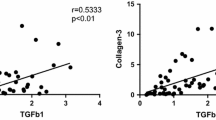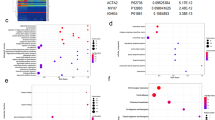Abstract
Purpose
Lumbar spinal stenosis (LSS) is the most common reason for spinal surgery in patients over the age of 65, and there are few effective non-surgical treatments. Therefore, the development of novel treatment or preventative modalities to decrease overall cost and morbidity associated with LSS is an urgent matter. The cause of LSS is multifactorial; however, a significant contributor is ligamentum flavum hypertrophy (LFH) which causes mechanical compression of the cauda equina or nerve roots. We assessed the role of a novel target, microRNA-29a (miR-29a), in LFH and investigated the potential for using miR-29a as a therapeutic means to combat LSS.
Methods
Ligamentum flavum (LF) tissue was collected from patients undergoing decompressive surgery for LSS and assessed for levels of miR-29a and pro-fibrotic protein expression. LF cell cultures were then transfected with either miR-29a over-expressor (agonist) or inhibitor (antagonist). The effects of over-expression and under-expression of miR-29a on expression of pro-fibrotic proteins was assessed.
Results
We demonstrated that LF at stenotic levels had a loss of miR-29a expression. This was associated with greater LF tissue thickness and higher mRNA levels of collagen I and III. We also demonstrated that miR29-a plays a direct role in the regulation of collagen gene expression in ligamentum flavum. Specifically, agents that increase miR-29a may attenuate LFH, while those that decrease miR-29a promote fibrosis and LFH.
Conclusion
This study demonstrates that miR-29a may potentially be used to treat LFH and provides groundwork to initiate the development of a therapeutic product for LSS.








Similar content being viewed by others
References
Portal A (1804) Cours d’anatomie médicale: ou élémens de l’anatomie de l’homme avec des remarques physiologiques et pathologiques, et les résultats de l’observation sur le siége et la nature des maladies, d’après l’ouverture des corps. Baudouin
Szpalski M, Gunzburg R (2003) Lumbar spinal stenosis in the elderly: an overview. Eur Spine J 12:S170–S175
Deyo RA, Mirza SK, Martin BI et al (2010) Trends, major medical complications, and charges associated with surgery for lumbar spinal stenosis in older adults. JAMA 303:1259–1265
Weinstein JN, Tosteson TD, Lurie JD et al (2010) Surgical versus non-operative treatment for lumbar spinal stenosis four-year results of the Spine Patient Outcomes Research Trial (SPORT). Spine (Phila Pa 1976) 35:1329
Chen Y-T, Wei J-D, Wang J-P et al (2011) Isolation of mesenchymal stem cells from human ligamentum flavum: implicating etiology of ligamentum flavum hypertrophy. Spine (Phila Pa 1976) 36:E1193–E1200
Sairyo K, Biyani A, Goel VK et al (2007) Lumbar ligamentum flavum hypertrophy is due to accumulation of inflammation-related scar tissue. Spine (Phila Pa 1976) 32:E340–E347
Abbas J, Hamoud K, Masharawi YM et al (2010) Ligamentum flavum thickness in normal and stenotic lumbar spines. Spine (Phila Pa 1976) 35:1225–1230
Takeda H, Nagai S, Ikeda D et al (2021) Collagen profiling of ligamentum flavum in patients with lumbar spinal canal stenosis. J Orthop Sci 26:560–565
Bushati N, Cohen SM (2007) microRNA functions. Annu Rev Cell Dev Biol 23:175–205
Lipps HJ, Postberg J, Jackson DA et al (2010) MicroRNAs, epigenetics and disease. Essays Biochem 48:165–185
Deng Z, He Y, Yang X et al (2017) MicroRNA-29: a crucial player in fibrotic disease. Mol Diagn Ther 21:285–294
Huang Y-H, Yang Y-L, Wang F-S (2018) The role of miR-29a in the regulation, function, and signaling of liver fibrosis. Int J Mol Sci 19:1889
Dai Y, Dai D, Mehta JL (2014) MicroRNA-29, a mysterious regulator in myocardial fibrosis and circulating miR-29a as a biomarker. J Am Coll Cardiol 64:2181
Zhang G, Zhang W, Hou Y et al (2018) Detection of miR-29a in plasma of patients with lumbar spinal stenosis and the clinical significance. Mol Med Rep 18:223–229
Al-Jarallah K, Al-Saeed O, Shehab D et al (2012) Ossification of ligamentum flavum in Middle East Arabs: a hospital-based study. Med Princ Pract 21:529–533
Benz RJ, Garfin SR (2001) Current techniques of decompression of the lumbar spine. Clin Orthop Relat Res 384:75–81
Chen J, Liu Z, Zhong G, et al (2014) Hypertrophy of ligamentum flavum in lumbar spine stenosis is associated with increased miR-155 level. Dis Markers 2014:
Livak KJ, Schmittgen TD (2001) Analysis of relative gene expression data using real-time quantitative PCR and the 2− ΔΔCT method. Methods 25:402–408
Manfei XU, Fralick D, Zheng JZ et al (2017) The differences and similarities between two-sample t-test and paired t-test. Shanghai Arch Psychiatry 29:184–187
Akoglu H (2018) User’s guide to correlation coefficients. Turk J Emerg Med 18:91–93
Chakraborty C, Sharma AR, Sharma G, Lee S-S (2021) Therapeutic advances of miRNAs: a preclinical and clinical update. J Adv Res 28:127–138
Simonson B, Das S (2015) MicroRNA therapeutics: the next magic bullet? Mini Rev Med Chem 15:467–474
Watts AE, Millar NL, Platt J et al (2017) MicroRNA29a treatment improves early tendon injury. Mol Ther 25:2415–2426
Lakemeier S, Schofer MD, Foltz L et al (2013) Expression of hypoxia-inducible factor-1α, vascular endothelial growth factor, and matrix metalloproteinases 1, 3, and 9 in hypertrophied ligamentum flavum. Clin Spine Surg 26:400–406
Zhong Z, Zha D, Xiao W et al (2011) Hypertrophy of ligamentum flavum in lumbar spine stenosis associated with the increased expression of connective tissue growth factor. J Orthop Res 29:1592–1597
Acknowledgments
We thank Jeremy D. Shaw and William F. Donaldson for their contributions. This work was supported by the Ferguson Laboratory of the University of Pittsburgh. Key words: ligamentum flavum, microRNA, lumbar spinal stenosis, spine, back pain.
Author information
Authors and Affiliations
Corresponding author
Ethics declarations
Conflict of interest
The authors have no conflicts of interest to disclose. No competing interests or funding.
Ethical approvals
IRB approval was obtained through the University of Pittsburgh to complete this study (IRB #19070209).
Additional information
Publisher's Note
Springer Nature remains neutral with regard to jurisdictional claims in published maps and institutional affiliations.
Rights and permissions
Springer Nature or its licensor (e.g. a society or other partner) holds exclusive rights to this article under a publishing agreement with the author(s) or other rightsholder(s); author self-archiving of the accepted manuscript version of this article is solely governed by the terms of such publishing agreement and applicable law.
About this article
Cite this article
Wawrose, R.A., Oyekan, A.A., Tang, Y.M. et al. MicroRNA-29a: a novel target for non-operative management of symptomatic lumbar spinal stenosis. Eur Spine J 33, 892–899 (2024). https://doi.org/10.1007/s00586-023-07671-y
Received:
Revised:
Accepted:
Published:
Issue Date:
DOI: https://doi.org/10.1007/s00586-023-07671-y




